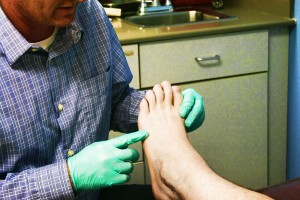A podiatric physician is sometimes needed to help with the care of toenails. From simple toenail trimming to more complex ailments, there are many conditions that can affect the toenails including thick, yellow, or brittle toenails, toenail fungus, tumors of the toenail, ingrown toenails, and many others. When home treatment does not work on any of the afflictions of the toenail, a specialist in podiatric medicine is necessary.
Ingrown toenails, also called onychocryptosis, occur when the toenail grows into the skin surrounding the nail rather than over it. It is most frequent in the big toe, but it can happen in any of the lesser toes as well. It can be a very painful condition, and the symptoms may include pain, redness, swelling, and infection with pus drainage.
 Anyone can get an ingrown toenail, but it is more likely to occur with adults than children. There is also a tendency for the condition to run in families. It is also more common for those with curved or thick toenails. Plus, picking at the toenail or overly aggressive pedicures can aggravate the problems. Moreover, there are many habits and lifestyle aspects of the condition. For example, those who cut their toenails too short, or round them, are more likely to have a problem with the nail growing into the skin. In addition, wearing shoes or socks that do not fit properly can result in the toenail being pushed into the surrounding skin. Also important to note is that injuries to the toe can be an issue. When you stub your toe or frequently kick a ball with your toes, for example, it can cause the toenail to grow in the wrong direction. When not properly treated, toenails are likely to re-grow into the skin. Other existing conditions that may play a part in the improper growth of the toenail include:
Anyone can get an ingrown toenail, but it is more likely to occur with adults than children. There is also a tendency for the condition to run in families. It is also more common for those with curved or thick toenails. Plus, picking at the toenail or overly aggressive pedicures can aggravate the problems. Moreover, there are many habits and lifestyle aspects of the condition. For example, those who cut their toenails too short, or round them, are more likely to have a problem with the nail growing into the skin. In addition, wearing shoes or socks that do not fit properly can result in the toenail being pushed into the surrounding skin. Also important to note is that injuries to the toe can be an issue. When you stub your toe or frequently kick a ball with your toes, for example, it can cause the toenail to grow in the wrong direction. When not properly treated, toenails are likely to re-grow into the skin. Other existing conditions that may play a part in the improper growth of the toenail include:
• Poor foot hygiene
• Abnormal gait
• Foot or toe deformities such as bunions or hammertoes
• Abnormally long toes
• Congenital toe deformities
• Obesity
• Diabetes
• Fungal infections
• Arthritis
• Bone or soft tissue tumors of the toe
• Excessive sweating
• Edema of the lower extremities
While there are some home remedies that can be tried, you will likely need to see a podiatric physician if the pain gets worse or if the toe is swollen, warm, or draining pus. There are several steps a doctor may choose to take at this point. She may prescribe an antibiotic, either orally or as a topical cream or ointment for the toe. In addition, it may be necessary to perform minor surgery to remove all or part of the toenail. This is done while the toe is numbed. The doctor may also perform an ablation, which destroys all or part of the nail root so that the nail will not grow right back into the skin.
Doctors who specialize in foot care will often suggest that patients wear loose and comfortable shoes to help prevent ingrown toenails. In addition, making sure to cut your toenails straight across is important since curved nails are often the source of problem. Some people may need to have the doctor trim their toenails on a regular basis so that the job is done in such a way as to be beneficial to the patient. This is especially true for diabetics or those with peripheral artery disease. If you are in Mesa, AZ, and you think you are having a problem with your toenail, please contact Dr. Brett Roeder so we can help you.

